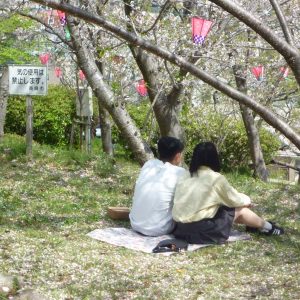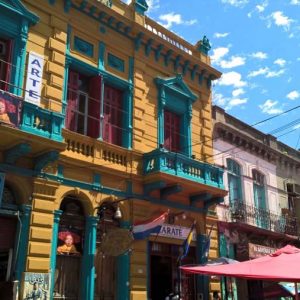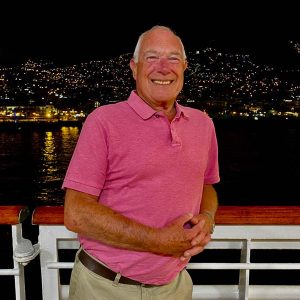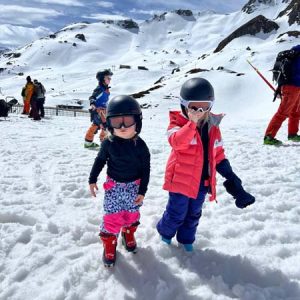“I’m off to Georgia” I told the neighbours, then had to explain that I meant the country, not the American state of the same name.
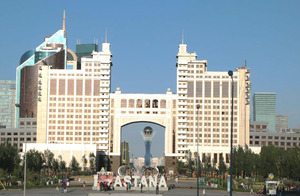 My destination was the capital, Tbilisi, but I went via Astana in Kazakhstan. I’d visited last year so was delighted to renew my acquaintance with the world’s weirdest, and newest, capital city with its geometric grid-shaped road pattern. Tbilisi, on the other hand, is so very different – old buildings and roads with bends in them.
My destination was the capital, Tbilisi, but I went via Astana in Kazakhstan. I’d visited last year so was delighted to renew my acquaintance with the world’s weirdest, and newest, capital city with its geometric grid-shaped road pattern. Tbilisi, on the other hand, is so very different – old buildings and roads with bends in them.
My flights were comfortable and the service excellent. No wonder Air Astana has won ‘Best airline in central Asia and India’ for the last six years.
On the way from Tbilisi airport to the hotel I noticed that some of the roads were not in great condition and the driving, well perhaps ‘undisciplined’ might be a polite description. However, I reached the Mercure Old Town hotel safely. My room was excellent with one of the most comfortable beds I have slept in. Outside there was a patio with swinging chair and gardens that were floodlit at night. The hotel is centrally located and the staff extremely helpful.
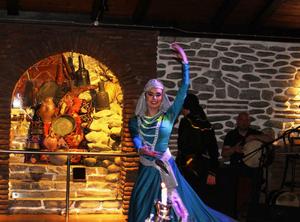 Tired from travelling I was not really in the mood for much more but I was taken to Tsiskvili. This is not just a restaurant but an entire Georgian experience – a feast with great entertainment. I and other diners sat down to a table laden with food, not sure how we were going to cope. What we didn’t realise was that this was just starters. More food kept arriving, musicians played and dancers danced, all in a lovely riverside setting. If you go, skip lunch, perhaps for several days.
Tired from travelling I was not really in the mood for much more but I was taken to Tsiskvili. This is not just a restaurant but an entire Georgian experience – a feast with great entertainment. I and other diners sat down to a table laden with food, not sure how we were going to cope. What we didn’t realise was that this was just starters. More food kept arriving, musicians played and dancers danced, all in a lovely riverside setting. If you go, skip lunch, perhaps for several days.
Next morning, after the lightest of breakfasts, except that I’m a sucker for chocolate croissants, I set off for the cave town of Uflistsikhe. 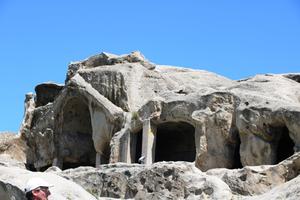 Built high on a cliff in Kartli and overlooking the Mtkvari River it is one of the earliest settlements in Georgia, going back three thousand years, and was a major centre in the pre-Christian era when the sun-goddess was worshiped. With the arrival of Christianity the focus moved to Mtskheta and Tbilisi but the town, which at its peak was home to an estimated 20,000 people, survived. A small Christian basilica from the ninth and tenth centuries sits at the top of the cliff.
Built high on a cliff in Kartli and overlooking the Mtkvari River it is one of the earliest settlements in Georgia, going back three thousand years, and was a major centre in the pre-Christian era when the sun-goddess was worshiped. With the arrival of Christianity the focus moved to Mtskheta and Tbilisi but the town, which at its peak was home to an estimated 20,000 people, survived. A small Christian basilica from the ninth and tenth centuries sits at the top of the cliff.
Prior to a lunchtime Georgian feast, this time at Mtskheta, I stopped at Gori, the birthplace of Joseph Stalin, leader of the Soviet Union from 1941 to 1953. 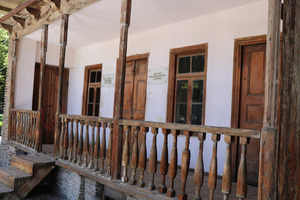 Protected by a Grecian-style structure is a small wooden house in which Stalin was born in 1878 and where he lived for the first four years of his life. Also on display is his personal Pullman railway carriage. Armour plated, it weighs over eighty tons. Used from 1941 it was this carriage that took him to the Yalta Conference in 1945 where he met with Roosevelt and Churchill to plan the shape of post-was Europe.
Protected by a Grecian-style structure is a small wooden house in which Stalin was born in 1878 and where he lived for the first four years of his life. Also on display is his personal Pullman railway carriage. Armour plated, it weighs over eighty tons. Used from 1941 it was this carriage that took him to the Yalta Conference in 1945 where he met with Roosevelt and Churchill to plan the shape of post-was Europe.
Mtskheta itself is hugely important to the Georgian people and their history. Dating back to the fifth century BC, it was the capital of Georgia for eight hundred years. 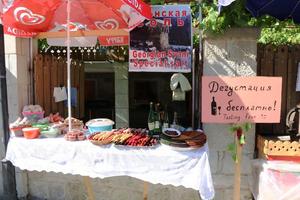 A small but bustling town, it’s popular with visitors. Shops selling souvenirs, local produce and more line the main street. The town in dominated by the Svetitskoveli cathedral. The first cathedral on the site was built in the fourth century but the present structure was built some seven hundred years later. Subject to numerous invasions, the cathedral features a defensive wall.
A small but bustling town, it’s popular with visitors. Shops selling souvenirs, local produce and more line the main street. The town in dominated by the Svetitskoveli cathedral. The first cathedral on the site was built in the fourth century but the present structure was built some seven hundred years later. Subject to numerous invasions, the cathedral features a defensive wall.
Legend has it that Jesus’s robe is buried here. It’s claimed a local Jew, Elias, was in Jerusalem when Jesus was crucified, purchased the robe from a soldier and brought it home with him where he was met by his sister Sidonia. She was so overcome with emotion when touching the robe that she died and was buried with the robe.
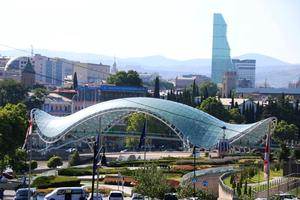 Then it was back to explore Tbilisi. The city got its name from the old Georgian word ‘tbili’ meaning ‘warm’ and is a reference to the hot sulphur springs producing three million litres a day that have led to a building of a number of spa bath houses. It sits astride the Mtkvari River and is almost completely surrounded by mountains. Perhaps the most spectacular of the river crossings is the Peace Bridge, a pedestrian bridge covered in a bow-shaped steel and glass structure. It has thousands of small LED lights which illuminate it at night. Another river crossing worth seeing is the Baratashvili Bridge, named after the poet Nikoloz Baratashvili. The bridge contains a number of bronze statues of stylised people looking along the river, sitting on the edge of the bridge and more.
Then it was back to explore Tbilisi. The city got its name from the old Georgian word ‘tbili’ meaning ‘warm’ and is a reference to the hot sulphur springs producing three million litres a day that have led to a building of a number of spa bath houses. It sits astride the Mtkvari River and is almost completely surrounded by mountains. Perhaps the most spectacular of the river crossings is the Peace Bridge, a pedestrian bridge covered in a bow-shaped steel and glass structure. It has thousands of small LED lights which illuminate it at night. Another river crossing worth seeing is the Baratashvili Bridge, named after the poet Nikoloz Baratashvili. The bridge contains a number of bronze statues of stylised people looking along the river, sitting on the edge of the bridge and more.
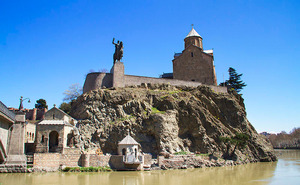 Overlooking the river is a rocky outcrop, one of the earliest inhabited areas of the city. King Vakhtang Gorgasali erected a palace and church here in the fifth century and there is a statue of him mounted on a horse next to the Metekhi Church, erected on the same site and dating back to the 13th century, although it has been restored on a number of occasions since then.
Overlooking the river is a rocky outcrop, one of the earliest inhabited areas of the city. King Vakhtang Gorgasali erected a palace and church here in the fifth century and there is a statue of him mounted on a horse next to the Metekhi Church, erected on the same site and dating back to the 13th century, although it has been restored on a number of occasions since then.
The main street is the mile-long Rustaveli Avenue which starts at Freedom Square. It’s home to the state Opera and Ballet Theatre, Rustaveli cinema, Youth Palace and the old Parliament building. It also has many shops and restaurants.
Tbilisi has a famous funicular railway which takes passengers up to Mtatsminda, 700 meters above sea level, where there is a large amusement park and restaurants. That evening I had dinner on a terrace overlooking the city – yet another Georgian feast.
It was time to go home; I was beginning to wonder if my clothes would ever fit me again.
More information
Air Astana offers return flights between Heathrow and Astana from £495 and return flights between Astana and Tbilisi from £215. All flights and accommodation can be booked through Air Astana. In addition, from 11 September, Air Astana offers a stop-over in Astana with transfers and hotel on a B&B basis for just $1 for the first night. Additional nights at standard rates. Go to www.airastana.com/uk/en-US Tel: 020 7644 6121 Mon-Fri, 0900–1730.
I Love Meet & Greet provides valet parking at Gatwick, Heathrow and Stansted airports. For more details and to book please visit www.ilovemeetandgreet.co.uk where you can also sign up to receive discount codes via email.

